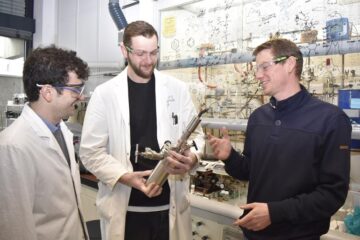A new tool to measure the speed of aging

A strong handshake can say a lot about a person—it can indicate power, confidence, health, or aggression. Now scientists say that the strength of a person’s grasp may also be one of the most useful ways to measure people’s true age.
In a new study published today in the journal PLOS ONE, IIASA researchers Serguei Scherbov and Warren Sanderson (also at Stony Brook University) show that hand grip corresponds to other markers of aging such as people’s future mortality, disability, cognitive decline, and ability to recover from hospital stays.
For their new research, Sanderson and Scherbov reviewed findings from over 50 published studies that focus on people of all ages around the world. Since the measure is already commonly used, data are readily available. “Hand-grip strength is easily measured and data on hand-grip strength now can be found in many of the most important surveys on aging worldwide,” says Sanderson.
The study also demonstrates how such a test could be used as a measure for aging to compare different population groups. The study used data from one such survey, the United States Health and Retirement Survey (HRS), to show how this could be done.
Scherbov says, “We found that based on this survey, a 65-year-old white women who had not completed secondary education has the same handgrip strength as a 69-year-old white women who had completed secondary education. This suggests that according to a handgrip strength characteristic their ages are equivalent and 65 year-old women ages 4 years faster due to lower education attainment.”
In a growing body of research funded in part by a new grant from the European Research Council (ERC), Scherbov and Sanderson have begun to define new measures of aging based on people’s characteristics, such as their longevity, health, disability status and other important demographic factors.
Previous research by Sanderson and Scherbov has shown that measuring age simply by the number of years people have lived does not measure variations in the aging process correctly. Using new characteristic-based approaches such as the one in this paper, using a physical test like hand-grip, the researchers can identify differences in the aging process between population groups that may not otherwise become apparent.
Scherbov says, “Our goal is to measure how fast different groups in a society age. If some group is getting older faster than another, we can ask why that might be and see whether there are any policies that could help the faster aging group.”
European Union’s Seventh Framework Programme (FP7/2007–2013)/ERC grant agreement to ERC2013-AdG 323947-Re-Ageing.
For more information please contact:
Serguei Scherbov
Deputy Program Director
World Population
T +43(0) 2236 807 584
scherbov@iiasa.ac.at
Warren Sanderson
Institute Scholar
World Population
T +43(0) 2236 807 252
T +1 631 828-4117
sanders@iiasa.ac.at
warren.sanderson@stonybrook.edu
Katherine Leitzell
IIASA Press Office
Tel: +43 2236 807 316
Mob: +43 676 83 807 316
leitzell@iiasa.ac.at
About IIASA:
IIASA is an international scientific institute that conducts research into the critical issues of global environmental, economic, technological, and social change that we face in the twenty-first century. Our findings provide valuable options to policy makers to shape the future of our changing world. IIASA is independent and funded by scientific institutions in Africa, the Americas, Asia, Oceania, and Europe. www.iiasa.ac.at
Media Contact
All latest news from the category: Social Sciences
This area deals with the latest developments in the field of empirical and theoretical research as it relates to the structure and function of institutes and systems, their social interdependence and how such systems interact with individual behavior processes.
innovations-report offers informative reports and articles related to the social sciences field including demographic developments, family and career issues, geriatric research, conflict research, generational studies and criminology research.
Newest articles

Lower dose of mpox vaccine is safe
… and generates six-week antibody response equivalent to standard regimen. Study highlights need for defined markers of mpox immunity to inform public health use. A dose-sparing intradermal mpox vaccination regimen…

Efficient, sustainable and cost-effective hybrid energy storage system for modern power grids
EU project HyFlow: Over three years of research, the consortium of the EU project HyFlow has successfully developed a highly efficient, sustainable, and cost-effective hybrid energy storage system (HESS) that…

Safer alternative for an explosive reaction
The chemical industry has been using a reaction with explosive chemicals for over 100 years – now Mülheim scientists have discovered a safer alternative. The Ritter Group of the Max…





















